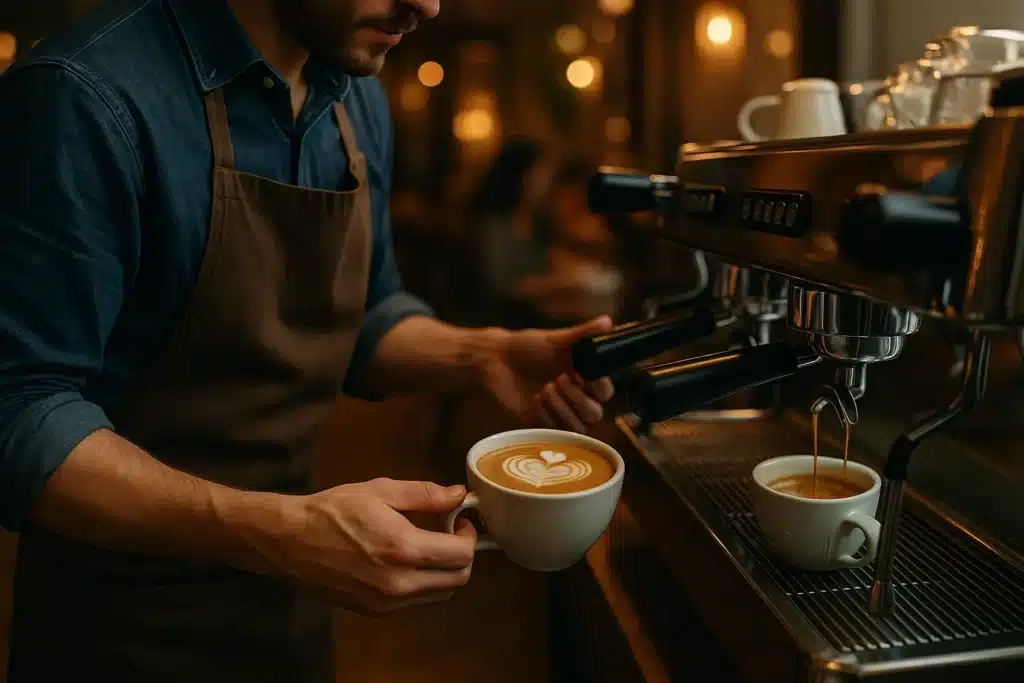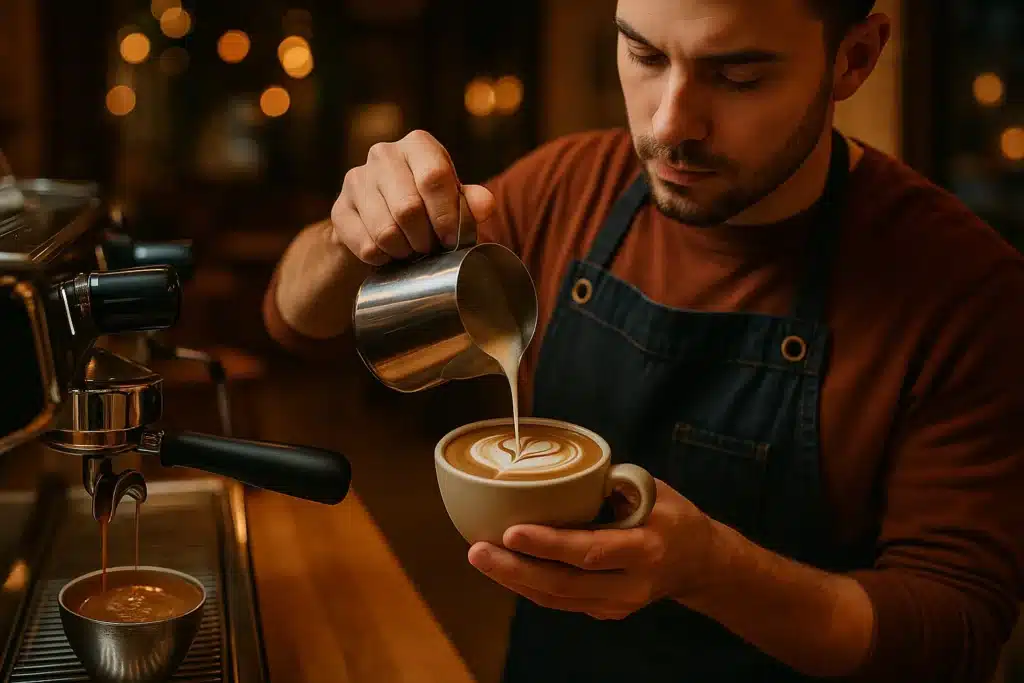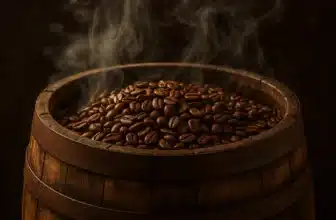
OneHundredCoffee is reader-supported, and some products displayed may earn us an affiliate commission. Details
There’s a moment, right before the café doors open, when the espresso machine hums like a cat and the grinders exhale that warm, toasty aroma. In that quiet, I like to ask myself: If a decaf drinker walked in right now, would we make them feel like a second-class guest—or would we surprise them with a cup so thoughtful they’d tell their friends about it?
For too long, decaf has been the punchline of old jokes and the neglected corner of the menu. But the data on customer habits, the realities of health and wellness, and the advances in decaffeination and roasting tell a different story. Decaf isn’t a compromise anymore; it’s an opportunity—commercially, creatively, and ethically. If you’re a barista or a roaster, taking decaf seriously can elevate your craft, grow your business, and earn the trust of guests who want everything great about coffee without the caffeine.
In this deep dive, we’ll strip away the myths, talk roast profiles, look at extraction adjustments, and show how a disciplined decaf program can become a competitive advantage. Think of this as a practical playbook born from real café shifts, roastery QCs, and late-night tasting sessions where we dialed in until the flavors finally clicked.

Decaf Isn’t a Niche—It’s a Market You’re Under-Serving
Walk through a weekday service and count: the parent grabbing a latte at 5 p.m., the athlete managing cortisol, the nurse coming off a night shift, the coffee lover sensitive to caffeine, the guest ordering a cappuccino after dinner without wanting a sleepless night. Decaf is the catchment for all these scenarios. The better your decaf, the more inclusive your menu becomes.
From a business standpoint, decaf is a relatively low-competition product category. Many cafés “set-and-forget” a single decaf and never revisit it. That makes excellence incredibly visible. I’ve watched regulars switch their evening drinks to our decaf espresso simply because we started treating it like a first-class option: fresh bags, posted tasting notes, and a dial-in card above the grinder. Within a month, we saw repeat decaf orders rise—and crucially, guests began recommending our shop to caffeine-sensitive friends. Word-of-mouth is strongest where surprise meets dignity.
Key takeaway: If your café does 250 drinks a day and only 5–8% are decaf now, pushing that to 12–15% with a properly tuned program can add meaningful revenue with minimal workflow disruption.
How Decaffeination Works—and Why It Matters for Flavor

“Decaf tastes flat” used to be more true than not. It’s far less true today. The main modern methods:
- Swiss Water® Process (SWP): Uses water and a proprietary green coffee extract to gently draw out caffeine while protecting flavor compounds. Typically yields a clean, sweet cup, often excellent for single-origin decafs and lighter roasts.
- CO₂ (Supercritical) Process: Uses supercritical CO₂ to selectively remove caffeine; generally preserves aromatics well and is common for espresso blends.
- Sugarcane / Ethyl Acetate (EA) Process: Often called “natural decaf,” EA is commonly derived from fermented sugarcane. The process can bolster sweetness and a round, caramelized feel—especially nice for milk drinks.
- Methylene Chloride (MC) Process: Highly selective for caffeine removal at relatively low temperatures. When executed with care at reputable facilities, it can retain distinct flavor clarity. Many roasters still choose MC decaf for espresso because it pulls a surprisingly vibrant shot with good crema.
None of these methods is a magic wand—you still need green coffee quality, smart roast development, and tight extraction. But they’re far better at flavor retention than the decaf of a decade ago, which means you can work with origin character rather than fighting against it.
Green Coffee Strategy: Choose Decaf with Intent
Roasters sometimes buy decaf like it’s a box to tick. Instead, treat it like a flagship SKU.
- Cup multiple decaf processes side-by-side. A honey-processed Colombia EA might sing as a milk-forward espresso; a Swiss Water Ethiopia could sparkle as a pour-over with bergamot and stone fruit.
- Prioritize freshness. Decaf greens age faster—stock fewer bags, turn inventory quickly, and write a decaf-specific purchase cadence (e.g., 8–10 week cycles).
- Look for transparent sourcing. Single-origin decaf is worth featuring on your menu; it tells a story and counters the “all decaf tastes the same” myth.
Roasters who define a decaf identity—“clean and bright filter,” “caramel-heavy milk shot,” or “comfort blend with cocoa and almond”—make better buying, roasting, and marketing decisions.
Roast Development for Decaf: The Art of Gentle
Decaf starts chemically different. The decaffeination process alters bean porosity, density, and moisture migration. In the drum, that means:
- Charge temperature: You might lower it a touch compared with your fully caffeinated counterpart. Watch how quickly the beans soak up heat early on.
- Rate of rise (RoR): Maintain a steady, gently descending RoR. Decaf can crash or flick more easily; you want a smooth curve to first crack.
- Development time: Err on the side of clarity over char. Many decafs benefit from slightly shorter post-crack time to avoid “baked” flavors.
- Color tracking: Surface color can be deceptive. Use a reliable colorimeter or track end-of-roast “AGTRON” or similar values to keep batches consistent.
A good working hypothesis: Decaf needs more finesse in early-to-mid roast, and restraint in development. Think “coax”, not “conquer.”
Dialing In Decaf Espresso: Small Tweaks, Big Wins

Behind the bar, your decaf deserves its own recipe card. Treat it like a top-tier single origin, and it will behave like one.
- Dose & yield: Many decafs like slightly tighter ratios (e.g., 1:1.8 instead of 1:2.2) to bring up body and sweetness. Start with your shop’s house ratio, then reduce the yield in 2–3 gram steps to locate the sweet spot.
- Grind: Decaf may need a bit finer to get the same flow time—its porous structure affects extraction. Move in small increments.
- Temperature: A minor bump (0.5–1.0°C) can unlock sweetness and crema stability, especially for EA or MC-processed decafs that already have a caramelized baseline.
- Rest time: Fresh decaf espresso often benefits from a day longer rest than your standard espresso (e.g., 6–10 days post-roast) to stabilize CO₂ and improve tactile feel.
Here’s a sample of starting points I’ve used successfully:
| Profile Goal | Dose (g) | Yield (g) | Time (s) | Temp (°C) | Notes |
|---|---|---|---|---|---|
| Milk-forward caramel | 18 | 32 | 28–30 | 93.5–94.0 | Tight ratio for body, slight temp bump |
| Balanced, sweet straight shot | 18 | 36 | 30–32 | 93.0–93.5 | Classic ratio, neutral temp |
| Bright, fruit-forward | 18 | 38–40 | 30–33 | 92.5–93.0 | Open the yield; watch acidity |
These are not rules—just pragmatic starting lines. Taste, adjust, repeat.
Brewing Decaf Filter: Let the Origin Speak
For pour-over and batch, decaf shines when you assume it has a voice. I like to brew decaf filter exactly like a celebrated seasonal—feature it on the menu, write tasting notes, and sample it proactively to after-dinner guests.
- Grind & ratio: Start with your normal 1:16–1:17 ratio. If the cup reads a little flat, tighten to 1:15.5 and bump total dissolved solids (TDS) slightly.
- Water temperature: 93–96°C works well; don’t be afraid of the higher end for washed decafs that present citrus or florals.
- Agitation: Be gentle. Excessive stirring can exacerbate astringency in some decafs; try pulse pours rather than aggressive agitation.
A café I worked with moved decaf from the “ask-only” shelf to a rotating filter feature with a simple sign: Sweet, cocoa, gentle red fruit. Sales doubled in a week, and we didn’t change anything but the story.
Water Chemistry and Decaf: Hidden Levers
Because decaf often aims for sweetness and tactility, your water can either lift or flatten it.
- Calcium vs. magnesium: Magnesium accentuates brightness and aromatics; calcium leans toward body and sweetness. A slightly calcium-forward profile complements many decaf espressos.
- Alkalinity: Keep alkalinity in check to avoid muting acidity entirely; in the 40–80 ppm as CaCO₃ range, the decaf filter can stay lively without harshness.
- Consistency: Whatever your target, hold it steady. Decaf’s narrower “comfort zone” rewards stable water more than heroic recipes.
If you already manage water for your café, try cupping your decaf across a couple of mineral targets—you’ll be surprised how much character emerges with a 20–30 ppm shift.
The Customer Experience: Selling Decaf Without Saying a Word
I’ve watched dozens of micro-interactions around decaf, and the best “sales” moments are not pushy—they’re welcoming.
- Menu language: Put your decaf where eyes land—on the main menu and the espresso board, not a footnote. List tasting notes with the same pride as your single origins.
- Proactive sampling: If a late-evening guest hesitates, a mini-sample of decaf filter removes risk and starts a conversation.
- Cup quality parity: Serve your decaf in the same cups, with the same latte art, with the same care. Guests notice. They always notice.
A guest once told me, “No one’s ever poured a heart in my decaf.” She became a regular.
Staff Training: Build Decaf into Your Dial-In Rhythm
If decaf is only dialed when a mystery order pops in, it will always feel like an interruption. Make it routine:
- Include decaf in the morning dial-in: one espresso shot and one filter brew. Record the recipe.
- Track tasting notes and flow rates in a shared log.
- Assign a weekly “decaf champion” who updates recipes, checks roast dates, and runs a mini cupping for the team.
The point isn’t bureaucracy; it’s ownership. When someone is proud of the decaf program, standards follow.
Quality Control in the Roastery: Treat Decaf Like a Headliner
At the roaster, I keep decaf QC on the same schedule as espresso blends:
- Sample roast & production cupping for each incoming lot and at each profile iteration.
- Color readings for pre- and post-roast to reduce batch-to-batch drift.
- Aging curves: Taste at day 3, day 7, and day 14 to map the window where the coffee peaks for espresso vs. filter.
Document everything. Decaf can be surprisingly expressive when your roast curve is repeatable.
Shelf Life, Packaging, and Rotation: Protect the Investment

Decaf degrades just like any coffee—but because so many shops move it more slowly, it appears to degrade faster. That’s a logistics problem, not a flavor destiny.
- Right-size your orders. Better to re-order monthly than to sit on three months of stock.
- Package smart. One-way valves, light-protected bags, and a predictable degassing window.
- Visible freshness. Put roast dates forward-facing on your café shelf. Fresh decaf sells itself.
Costing and Pricing: Decaf Isn’t a Discount Drink
Decaf green often costs more than its caffeinated counterpart. Don’t hide that cost—calculate it, own it, and price accordingly. If your decaf espresso is a carefully sourced single-origin with longer rest, it’s a premium product. Your customers will pay for quality and transparency, especially if the experience consistently delivers.
A quick café math snapshot:
| Item | Regular Espresso | Decaf Espresso |
|---|---|---|
| Green Cost (per kg) | Moderate | +10–25% |
| Rest Needed | 3–7 days | 6–10 days |
| Waste Risk | Standard | Slightly higher (slower turn) |
| Menu Price | Baseline | Baseline or +$0.25 |
| Gross Margin (typical) | Healthy | Healthy if priced/managed |
It’s okay to add a small premium if your costs demand it—just ensure guests understand they’re drinking a carefully developed coffee, not a compromise.
Handling and Workflow: Make Decaf Easy to Execute

Two common café pain points: cross-contamination and grinder over-commitment. Solutions:
- Dedicated decaf hopper or single-dose workflow. A small single-dose works wonders for keeping decaf fresh and separate.
- Purge discipline. If sharing a grinder (not ideal), standardize a purge weight and write it on the recipe card.
- Milk pitcher labeling. If you use separate pitchers, color-code to prevent mix-ups during rush.
- Batch brew timing. If your decaf filter moves slowly, brew in smaller batches more frequently (or use high-quality airpots) to maintain freshness without waste.
Remember: every friction point removed increases the chances that staff will champion decaf rather than avoid it.
Myth-Busting: “Decaf Can’t Taste Like Real Coffee”
Let’s say it clearly: great decaf tastes like great coffee. Will it have the identical sparkle of a 92-point washed Ethiopia? Not always. But it can show layered sweetness, original character, and a satisfying finish.
I once ran a blind tasting with the team: two decaf and two caffeinated coffees. After twenty minutes of slurping and note-taking, no one correctly identified all the decaf. Most of us miscalled at least one. The ddecafone EA Colombia and one Swiss Water Central American blend—held their own with chocolate, red apple, and a touch of orange zest. The room got very quiet. Then we completely rewrote our decaf menu copy.
Building a Decaf Lineup: Espresso, Filter, and Seasonal
A simple structure serves most shops and roasteries well:
- Decaf Espresso: Round, viscous, caramel-forward. Process: EA or MC commonly.
- Decaf Filter / Single Origin: Cleaner, fruit or floral leaning. Process: SWP or CO₂ commonly.
- Seasonal Decaf Feature: Rotate per quarter to tell fresh stories and delight regulars.
Add tasting notes to your menu board. Treat the decaf tasting notes as a promise and you’ll build trust quickly.
Sensory Language for Decaf: Evoke, Don’t Excuse
Stop apologizing for decaf in your copy. Use the beautiful language you already use:
- “Silky cocoa and toasted almond with a cherry finish.”
- “Orange blossom aroma, milk-chocolate sweetness, and a lingering caramel aftertaste.”
- “Velvety body, brown sugar, and whispers of plum.”
When you present decaf with romance and precision, guests recalibrate their expectations before the first sip.
Training Your Palate: A Decaf Cupping Framework
Roasters and baristas grow fast when they cup decaf with intention. Try this three-flight structure:
- Process Flight: SWP vs. EA vs. MC vs. CO₂—same origin or similar profiles. Note texture, sweetness, and top notes.
- Roast Flight: Two roast curves of the same decaf—one with shorter development, one longer. Map where sweetness peaks vs. dryness creeps in.
- Brew Flight: Espresso, V60, and a batch of the same decaf. Teach your team how the coffee “speaks” across formats.
Document takeaways in a shared logbook and let those notes guide your buying and roasting.
Troubleshooting Decaf: Common Issues and Fixes
- Flat cup, weak sweetness: Increase extraction—tighten brew ratio (1:15.5), grind slightly finer, or raise water temp 1°C.
- Astringency / dry finish: Coarsen grind a notch, reduce agitation, or shorten espresso yield by 2–3 grams.
- Hollow espresso body: Increase dose by 0.5–1.0 g or lower the yield target; consider a 0.5°C temp rise.
- Crema collapses quickly: Extend rest time by 1–2 days; ensure grinder burrs are sharp and hopper is closed between shots.
I keep a decaf “triage card” by the grinders—a quick matrix of symptoms and first-line fixes. It saves time mid-rush.
Pairing and Menu Engineering: Make Decaf Irresistible
- Evening dessert menu: Feature a decaf cappuccino with a short pairing note: “Pairs beautifully with lemon tart.”
- Signature drinks: A maple-oat decaf latte or an orange-spice decaf tonic can become a cult favorite.
- Retail shelf: Offer 250 g bags of your current decaf with the same label design as your flagship espresso. Visibility breeds respect.
We once created a winter “Cocoa Almond Decaf Mocha” with a house almond syrup and a dark chocolate ganache. It outsold the regular mocha after 6 p.m.—because it made sense for the moment people were in.
The Ethics of Decaf: Inclusion Is a Value
Serving decaf well is hospitality at its purest—an affirmation that coffee culture isn’t reserved for a single metabolism. For some guests, caffeine triggers palpitations. For others, it aggravates anxiety, reflux, or disrupts medications. Some are pregnant; others just want to sleep by midnight.
When we make decaf exceptional, we say: You’re welcome here. We made something beautiful for you, too.
A Simple Café Rollout Plan (Six Weeks to a Standout Decaf Program)
Week 1–2: Source and cup three decaf options (different processes). Choose one for espresso and one for filter. Write first draft tasting notes.
Week 3: Test roast curves (for roasteries) or dial in on the bar with a dedicated recipe card. Adjust water temperature and yield until sweetness is consistent.
Week 4: Update menu boards, website descriptions, and staff training binder. Buy retail bags with fresh roast dates.
Week 5: Launch with a small promo: half-price decaf filter after 6 p.m. for three days. Encourage samples.
Week 6: Review sales, waste, and customer feedback. Tweak brew ratios and signage. Schedule monthly cuppings.
Keep it lightweight, honest, and iterative. The plan isn’t to be perfect by Friday; it’s to be better every week.
For Roasters: Branding and Wholesale Education
If you’re a roaster, equip your wholesale partners:
- One-page brew guide with decaf-specific notes.
- Talking points for staff: process explanation, origin story, ideal flavor descriptors.
- Retail collateral: shelf talkers that feel like a gift to the decaf drinker, not a technical diagram.
Host a quarterly “Decaf Masterclass” cupping. You’ll elevate your brand and prove—by tasting—that your decaf stands apart.
Advanced Topic: CO₂ vs. EA vs. SWP for Espresso
In side-by-side espresso tests:
- EA often yields a plush, maple-caramel baseline that marries well with milk. Body is the headline, and acids are friendly.
- MC can surprise with clarity and crema. It’s a sleeper hit for straight shots when roasted and rested properly.
- SWP leans toward cleanliness and original expression. Gorgeous in straight shots if your bar tolerates a slightly more sensitive dial-in; exquisite in Americano, where clarity matters.
- CO₂ straddles a middle path—solid aroma retention and balanced extractions.
Map your guests: if 70% of decaf espresso goes into milk, lean EA or MC. If straight shots and Americanos dominate, SWP or CO₂ can shine.
Sensory Benchmarks: What “Good” Decaf Tastes Like
- Aroma: Cocoa, light nut, gentle fruit florals; no cardboard or “wet paper” notes.
- Acidity: Measured but present—think red apple, orange zest, or dried cherry rather than lemon snap.
- Sweetness: Dominant; brown sugar, caramel, honey.
- Body: Silky to round; in espresso, crema is stable enough for latte art.
- Finish: Clean, with either cocoa-linger or a faint fruit echo.
If you hit those marks consistently, your decaf will convert skeptics.
The “Best 5 Decaf Selections” to Explore
| Image | Product | Features | Price |
|---|---|---|---|
 | Best Decaf Coffee
| Price on Amazon | |
Best Budget  | Best Budget
| Price on Amazon | |
Best Decaf Coffee  | Best Decaf Coffee
| Price on Amazon | |
Best Overall  | Best Overall
| Price on Amazon | |
Best Price  | Best Price
| Price on Amazon |
1) Decaffeination Methods & Flavor Tendencies
| Method | Common Flavor Tendencies | Best Use Cases | Bar Notes |
|---|---|---|---|
| Swiss Water® | Clean, sweet, origin-forward | Filter, bright espresso | Needs precise dial-in; rewards clarity |
| EA (Sugarcane) | Caramel, round, plush | Milk-forward espresso | Crowd-pleaser; excellent with 6–8 oz milk |
| MC | Clear, aromatic, strong crema | Espresso shots & americanos | Surprising complexity; rest well |
| CO₂ | Balanced, aromatic | Versatile across formats | Stable and consistent on bar |
2) Café Recipe Starting Points
| Format | Ratio / Target | What to Expect |
|---|---|---|
| Espresso (18 g → 32–36 g in 28–32 s @93–94°C) | Round, sweet, stable crema | Adjust yield for body vs. brightness |
| V60 (20 g → 320–340 g, 2:45–3:15) | Clean, articulate | Higher temp highlights florals |
| Batch (1:16, 2.0–2.1 TDS target) | Comfort, clarity | Keep hold times tight; smaller batches more often |
3) Inventory & Rotation
| Practice | Why It Matters | Target |
|---|---|---|
| Smaller, more frequent orders | Keeps flavor peak on tap | 4–8 week turnover |
| Rest time tracking | Stabilizes espresso texture | 6–10 days post-roast |
| Menu visibility | Normalizes decaf as equal | On main board + espresso board |
Hospitality Scripts That Work (and Feel Natural)
- Guest: “Is your decaf any good?”
Barista: “It’s one of our favorites—caramel and cocoa with a cherry finish. Want a small sip of today’s brew?” - Guest at 7 p.m.: “I want something cozy, but it’s late.”
Barista: “Our decaf cappuccino is perfect at this hour—sweet and velvety. I can make it with oat if you like.” - Wholesale partner: “Our decaf doesn’t move.”
Roaster: “Let’s try a Swiss Water single-origin for filter and an EA decaf for espresso, give the team dial-in cards, and promote a 3-day evening special. We’ll measure and refine.”
Scripts aren’t about manipulation; they help your team confidently share what you’ve carefully crafted.
A Values-Driven Decaf Program: Inclusivity, Quality, and Story
Your decaf can be the most visible expression of your café’s or roastery’s values:
- Inclusivity: Coffee for everybody and every hour.
- Quality: Roast curves logged, recipes tracked, and tasting notes honest.
- Story: Origins, farmers, and processes explained without jargon; just enough detail to welcome curiosity.
When you connect those dots, your decaf stops being a checkbox and becomes a signature.
Real-World Case Study: Turning “Okay” Decaf into a Bestseller
A neighborhood café was moving 8–12 decaf drinks a day. We made four changes:
- Swapped a generic decaf blend for a Swiss Water single-origin for filter and an EA decaf for espresso.
- Wrote playful, precise tasting notes on the board.
- Added decaf to the morning dial-in and taped a recipe card to the grinder.
- Offered a three-day evening special: free 2-oz decaf pour-over sample with any pastry after 6 p.m.
Within three weeks, decaf drinks averaged 30–35 daily, pastries went up in lockstep, and regulars began asking when the next decaf feature would arrive. The café didn’t have to reinvent itself—just decide that decaf drinkers deserved the good stuff.
Your Decaf Playbook: From Intention to Habit
If you’re a barista, try making 10 decaf shots this week—taste them, take notes, and create your favorite recipe. If you’re a roaster, organize a decaf-only cupping and invite your wholesale partners to join. Then, if you manage a café, give decaf equal prominence on your menu and observe how customers react.
Decaf is not the shadow of coffee; it’s a spectrum within it. When we take it seriously, we make better coffee for more people, more of the time. That’s not just good hospitality—it’s good business, and it’s more fun.
So tomorrow morning, before the doors open and the grinders start to sing, pull a decaf shot for yourself. Taste it with curiosity. Adjust two variables. Then write the recipe down. That simple act, repeated day after day, is how a culture changes—one sweet, honest cup at a time.






